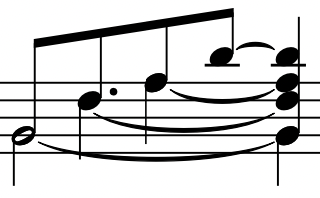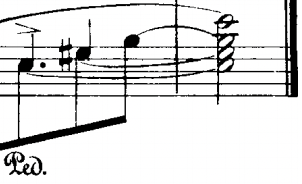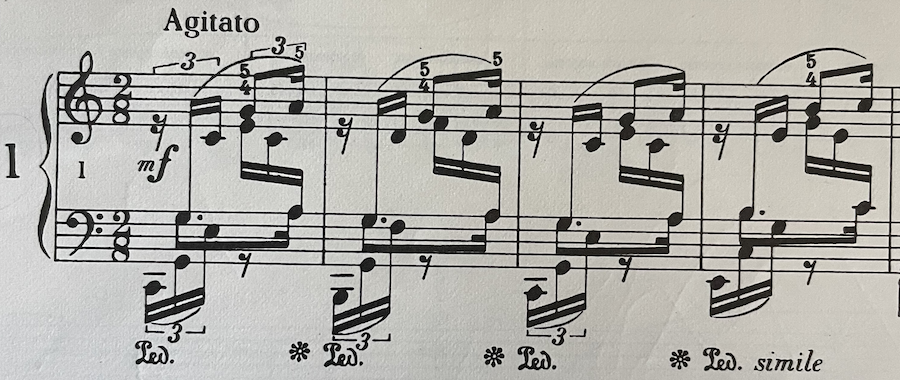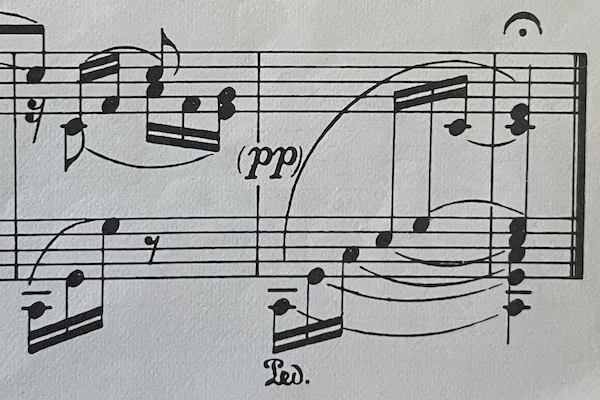I came across a bar that sounds like this while transcribing a piece for keyboard. Is there a correct/better way to write this?
What's the proper piano notation for adding one note at a time to a chord and holding all the notes?
3 Answers
A broken chord like this is notated with double stems for each note. One set of stems corresponds to the eighth-note onsets of each pitch. The second set of stems corresponds to the duration of each pitch and shows the tie to the final, full chord.
It is acceptable to use shared note heads in this kind of situation. For example, the first note could have a half-note head, but an eighth-note stem.
Here is a similar example from the left hand, final two measures of Brahms's "Intermezzo" Op. 119, No. 2. Note here that Brahms clearly expects the fingers to sustain the pitches. The pedal marking is not for the sustain, but rather for the "warmth" of the overall sound.
A second example, from Chopin, shows the importance of the ties versus a simple pedal indication.1
This first image is the first four measures of Chopin's Prelude in C major, Op. 28, No. 1, from the Paderewski edition (i.e., this is Paderewski's interpretation of how this should be played). Note the one-pedal-per-measure scheme, which is marked "Ped. simile" ("keep pedaling in the same way") in the fourth measure.
However, this notation clearly does not mean to hold all notes of the chords. The sound would be extremely muddy. Consider this notation in light of the final three measures (mm. 32–34), shown below. Measure 32 is played as shown in mm. 1–4, but measures 33 and 34 are explicitly tied to illustrate the intention of a slowly arpeggiated block chord. (Also, the absence of double note heads is another alternative notation that is sometimes used.)
-
4Just a warning: this may make sense for keyboards, but string instrument players could interpret this as unison double-stops (not that we could play all 4 pitches but we could possibly achieve 2 pitches) Commented Jun 21, 2021 at 15:30
-
3@CarlWitthoft Even that is only true for bowed string instruments. Plucked string instruments like guitars can play 4 notes in true unison (5 if the little finger is used, which is rare but possible), and a strum can sound all the strings for a block chord. Also bowed instruments played pizzicato become plucked instruments, of course, and can do the same.– GrahamCommented Jun 22, 2021 at 9:58
-
The Brahms example doesn't show double note heads, but is an alternate form in which a tie between a note of any duration and the next note is assumed to extend the duration of the first.– supercatCommented Jun 22, 2021 at 14:45
-
@supercat The Brahms has "overlapping" note heads. The double stems are one clue, but the dot on the first note displayed is the important detail. The Chopin does show the notation you describe.– AaronCommented Jun 22, 2021 at 15:11
-
@Aaron: Ah, for some reason I hadn't seen the stems. I mistook that example for an approach I've seen which uses ties to extend a note to a non-consecutive note. Whether or not any formal rules of notation recognize that meaning, I think it makes the extension of notes more visually obvious than the presence or absence of stems, especially in cases where some notes are extended and others not, and the last note is a non-extended eighth note (which reproduces all the earlier tied notes that end there, so the other ties have something to connect to).– supercatCommented Jun 22, 2021 at 16:11
Just based off of the span of these pitches, most players can't play all of these pitches with one hand (assuming either a B♭–D or B–D♯ span).
As such, I would argue that pedaling is the best bet. Just write the pitches as normal eighth notes, but indicate to the player to hold down the pedal, thereby sustaining the pitches until the pedal sign changes:
It's true that pedaling could muddy up the melody notes in the right hand (depending on how active they are), but an accomplished pianist should be able to use pedal without sacrificing melodic clarity.
If the right hand is too much for the pedal, you could also clear up the notation by using simple eighth notes (as in the above example) but with a text indicator to the performer: "sustain all left-hand pitches for the duration of the measure."
PS: How funny that When piano pedalling seems to conflict with the original score was asked almost simultaneously with this one, since it connects with my answer exactly.
-
1Hmmmm... //rushes off to design a piano with a set of "selective" Pedals Commented Jun 21, 2021 at 15:31
-
3An accomplished pianist would understand this notation to mean that it's not necessary to retain all four LH notes and would sacrifice some, if necessary, in service of the melody.– AaronCommented Jun 21, 2021 at 15:45
-
Half pedalling would probably get close, without muddying the r.h. Or - use of sostenuto would, in some circumstances, be a solution.– TimCommented Sep 5, 2021 at 7:49
That's the way I've seen it. Obviously a wavy line won't do the job, a player would play the notes too quickly in succession.
The other way would be to write the lowest note as full value, and write as SATB, using rests before each of the other notes, which would then have their own appropriate values, losing a quaver each time in your example. But that's even messier.
Or - write out the first 3 quavers consecutively, each tied across to those same notes to, say, a minim chord to fill the bar. It's not technically correct, but tidies it all up, and the expected result is more than apparent.







